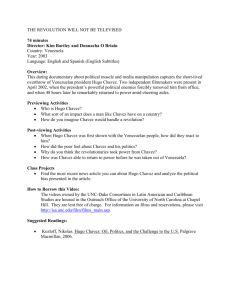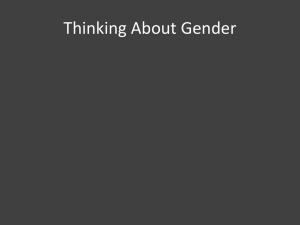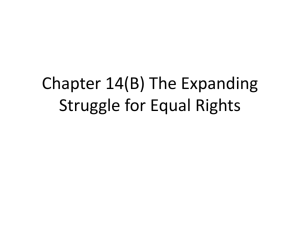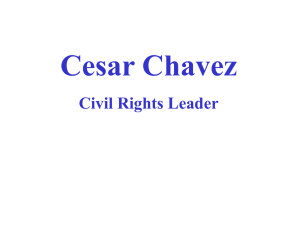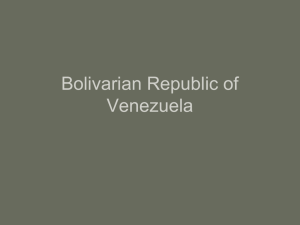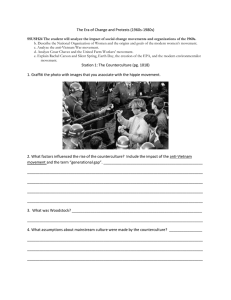EDUCATION AS LIBERATION: THE BOLIVARIAN ALTERNATIVE HUGO CHAVEZ (1954-2013) Peter McLaren
advertisement
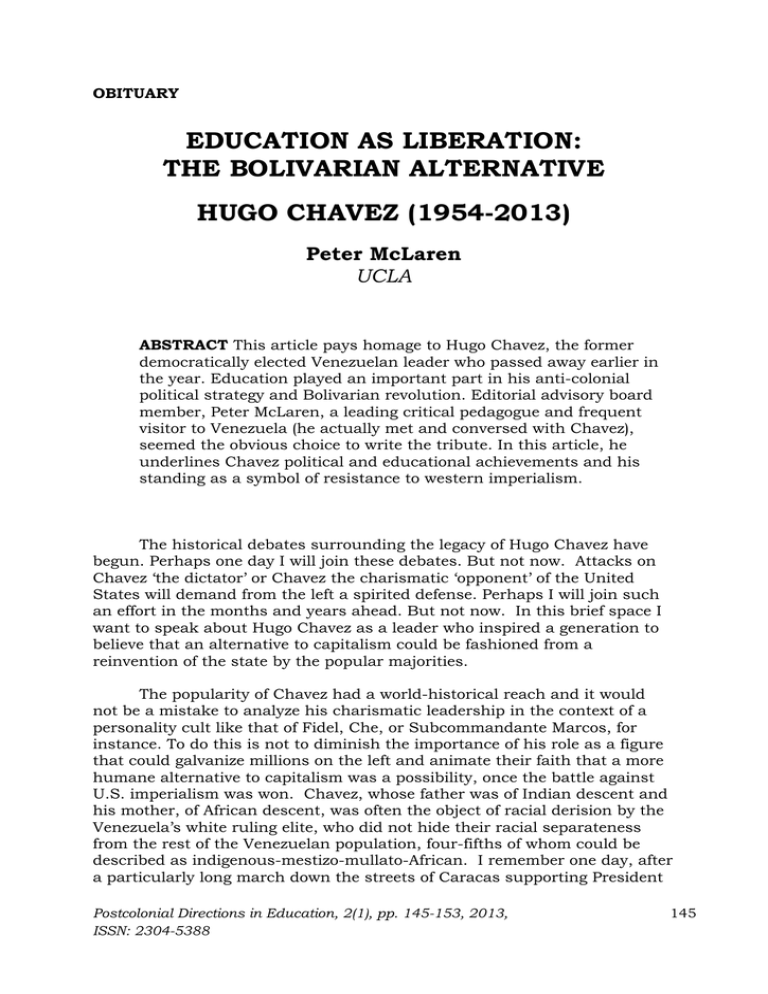
OBITUARY EDUCATION AS LIBERATION: THE BOLIVARIAN ALTERNATIVE HUGO CHAVEZ (1954-2013) Peter McLaren UCLA ABSTRACT This article pays homage to Hugo Chavez, the former democratically elected Venezuelan leader who passed away earlier in the year. Education played an important part in his anti-colonial political strategy and Bolivarian revolution. Editorial advisory board member, Peter McLaren, a leading critical pedagogue and frequent visitor to Venezuela (he actually met and conversed with Chavez), seemed the obvious choice to write the tribute. In this article, he underlines Chavez political and educational achievements and his standing as a symbol of resistance to western imperialism. The historical debates surrounding the legacy of Hugo Chavez have begun. Perhaps one day I will join these debates. But not now. Attacks on Chavez ‘the dictator’ or Chavez the charismatic ‘opponent’ of the United States will demand from the left a spirited defense. Perhaps I will join such an effort in the months and years ahead. But not now. In this brief space I want to speak about Hugo Chavez as a leader who inspired a generation to believe that an alternative to capitalism could be fashioned from a reinvention of the state by the popular majorities. The popularity of Chavez had a world-historical reach and it would not be a mistake to analyze his charismatic leadership in the context of a personality cult like that of Fidel, Che, or Subcommandante Marcos, for instance. To do this is not to diminish the importance of his role as a figure that could galvanize millions on the left and animate their faith that a more humane alternative to capitalism was a possibility, once the battle against U.S. imperialism was won. Chavez, whose father was of Indian descent and his mother, of African descent, was often the object of racial derision by the Venezuela’s white ruling elite, who did not hide their racial separateness from the rest of the Venezuelan population, four-fifths of whom could be described as indigenous-mestizo-mullato-African. I remember one day, after a particularly long march down the streets of Caracas supporting President Postcolonial Directions in Education, 2(1), pp. 145-153, 2013, ISSN: 2304-5388 145 Chavez, I went from store-to-store in an attempt to purchase a popular Chavez doll as a souvenir. But there was not a single doll to be found. I was told that I could find one in Altamira, an affluent east Caracas neighborhood. I was surprised. A fellow camarada laughed at my expression and told me that the white ruling elite--often referred to as “esqualidos” (a colloquialism for squalid people)--had plenty of Chavez dolls available in their upscale stores. Referring to Chavez as “ese mono” (that monkey), they would tie the dolls to the bumpers of their cars and drag them through the streets. The contrast between the cold and dispassionate statement released by the Obama administration after the death of President Chavez and spirited praise of Chavez by the fourteen Latin American countries that decreed official days of mourning for him could not have been more stark. Shattering the din created by the heartfelt outpourings of grief, respect and admiration from Latin American heads of state for this towering figure on the world stage who sported a trademark red beret, was the stony silence of the White House statement that offered no condolences, a fact that revealed the United States was the real corpse at Chavez’s funeral, and the spirit of the corpse that everyone was mourning was very much alive and sizzling in the afternoon air, like a freshly cooked arepa that Chavez loved so much. The fact that Chavez was so vocal about condemning the role of the Colossus of the North (a phrase used by artist Diego Rivera to describe the United States) and American-style capitalist imperialism did not mean that many other Latin American presidents didn’t sympathize with his views. But they did not want to appear on the certified list of enemies of the United States. Chavez was the most courageous of them all, and allowed himself to serve as a lightning rod for anti-imperialism in Las Americas and a harbinger for the "second independence" of South America. That is not to say that Nestor and Cristina Kirchner in Argentina, Lula da Silva and then Dilma Rousseff in Brazil, Evo Morales in Bolivia, Daniel Ortega in Nicaragua, Fernando Lugo in Paraguay, Jose "Pepe" Mujica in Uruguay and Mauricio Funes in El Salvador were not oftentimes courageous and valiant in their stance against U.S. imperialism. But it was Chavez that carried the banner. As Marc Weisbrot and others have noted, these leaders were well aware that all of Latin America benefitted from the leadership of Hugo Chavez, where the poverty rate fell in Latin America from 42 percent at the beginning of the decade to 27 percent by 2009. But no leader had as much charisma, nor control over such vast oil reserves, as Hugo Chavez. A military man, Chavez was better positioned than most to be aware of the devastating destruction the U.S. wreaked on populations in Latin America by its military support of the death squads in, El Salvador, Chile, Brazil, Nicaragua, not to mention more distant locations such as Korea, Vietnam, Laos, Grenada, Iraq, and where radioactive contamination from depleted uranium shells is still wreaking havoc on the unborn as well as the Postcolonial Directions in Education, 2(1), pp. 145-153, 2013, ISSN: 2304-5388 146 living. –through his efforts at the formation of UNASUR (the Union of South American Nations), CELAC (the Community of Latin American and Caribbean Nations) and ALBA (the Bolivarian Alliance for the Peoples of Our America), the latter of which aspired to set up a multi-polar global system embedded in international relations more adequate for the needs and potentials of developing countries. Insinuating itself into our daily life as an ideology as much as a set of accumulation practices and processes of production, neoliberal capitalism pretends to the throne of democracy-building but in reality it has hastened its demise. Capitalism wears a coquettish and self-effacing sheen of timelessness, inviolate consistency, and seamless immutability, but that sheen is not any more permanent than the lipstick on a mirror, or than the Barry Manilow hits played on vibraphone wafting through the shopping malls, or than one of Charles Bukowski’s famous beer farts. What makes capitalism seem indelible yet imitable is the fact that it makes certain people very rich, and these paragons of the capitalist class are those that the state media apparatuses parade in its garish media outlets—the movie stars, the corporate moguls, the trend-setters, the celebrities and the culture brokers. While news of celebrity cellulite shakes us awake with amphetamine alertness, we are provided by Hollywood gossip barons, equipped with the most profound and galvanizing lucidity available on which star has the best bikini body. At the same time, we remain emotionally drowsy to the pain and suffering of people who struggle and strain against falling household wealth, unemployment and lack of food and medical care. And we rarely cast our eyes south of the border. Hugo Chavez raised the stakes for North Americans. He showed us that a President could be democratically elected many times and still direct the majority of his efforts at helping the poor and disenfranchised help themselves. He made us aware that the comfort we enjoyed in the United States was a direct result of the enforced dependency that the US created with Las Americas. He showed the world that the class struggle is no longer demarcated by men in boiler suits or railhead pants versus factory owners in top hats, continental cross ties and double-breasted vests. Or the sansculottes versus the breech-garbed ruling class. Or financiers with capes and silver-tipped canes exploiting the labor power of frutiers, cobblers and copper miners lugging luchpails of lost dreams. The struggle, as he would tell us in his weekly television show, Alo Presidente, is the transnational capitalist class against all those who depend upon wages for their labor. He showed us that we need cultures of contestation that are transnational in scope to end the exploitation of capitalism. Chavez’s Bolivarian Circles (named after Simon Bolivar serve as watchdog groups modeled after Cuba’s Committee for the Defense of the Revolution and function as liaisons between the neighborhoods and the government as well as fomenting support for Chavez) were important in combating business leaders and dissident army generals whom, with U.S. support, were trying to Postcolonial Directions in Education, 2(1), pp. 145-153, 2013, ISSN: 2304-5388 147 overthrow the Chavez government. Members of the Bolivarian Circles would bang on hollow electricity poles to warn against mobilizations by the opposition and to rally supporters across the city’s working-class neighborhoods. They were an example of self-determination for sovereignty as evidenced by the Bolivarian declaration “Nuestra America: una Sola Patria” (Our America: one motherhood) which rejects an ideological loyalty to “America” as an America defined by a capitalist laden value system that favors imperialism and exploitation for increased profit margins. Chavez created an infrastructure for communal councils and for self-management in factories and cooperatives and for participation in social programs. This was an astonishing accomplishment because never before did the people living in the barrios have a real chance to participate in the government. For a leader to take the position of working from a preferential option of the poor and powerless and to be re-elected more times than any other leader in the western hemisphere (in the same amount of time)--and to survive a U.S.supported coup in 2002 and oil strikes that crippled the economy--that is quite a feat. Even Jimmy Carter has praised the election process in Venezuela as among the fairest he has observed. Chavez’s policies pointed towards the importance of ‘development from below’ which could be achieved through the democratization of the workplace by way of workers’ councils and a major shift of ownership of production, trade and credit in order to expand food production and basic necessities to the poor who inhabit the ‘internal market.’ Once President Chavez was able to control the oil industry, his government was able to reduce poverty by half and extreme poverty by 70 percent. Public pensions rose from 500,000 to over two million. Chavez helped turn Venezuela from being one of the most unequal countries in Latin America to (after Cuba) being the most equal in terms of income. Capitalism works through a process of exchange-value, whereas Chavez was more interested in the process of communal exchange—that is, to cite but one example, exchanging oil for medical care in a program with Cuba in which Cuban doctors were brought into Venezuela and were set up in various barrios. I remember once I was very ill with a fever off the charts and had to call a doctor, but before the doctor arrived I struggled in vain to pull my Che t-shirt over my drenched body to express a sign of solidarity from this ailing gringo. Chavez followed the principle of “buen vivir” which can be translated as “to live well.” But this term, which has indigenous roots, is very different from the North American term, “the good life.” Buen Vivir requires that individuals in their various communities are in actual possession of their rights and are able to exercise their responsibilities in the context of a respect for diversity and in accordance with the rights of ecosystems. Its about social wealth—not material wealth. I was privileged to be a guest several times on Alo Presidente, once when sitting next to Ernesto Cardinal. I listened to Ernesto wax eloquently about Chavez, and Chavez’s dream of bringing humanity together through a Postcolonial Directions in Education, 2(1), pp. 145-153, 2013, ISSN: 2304-5388 148 deep spiritual love. I attended meetings of the misiones, social programs in health, education, work and housing, set up by Chavez when he came into office in 1999 to help the poor to become literate, to finish high school, to organize their communities and to get medical attention. In 2005, when President Chavez offered residents of the Bronx a new type of program to heat homes, it was ridiculed as a cheap publicity stunt in the US media. Chavez was using the profits from his nation’s rich oil reserves to enact social spending programs, and was offering residents of the Bronx the same deal, which meant he would provide home heating oil to economically disadvantaged residents at a major discount—through Citgo— provided the savings that were made were reinvested into programs that benefitted the poor. Veteran Congressman José Serrano has since voiced his praise of Chavez for instituting this program in his district. In 2006, when I was denounced by a right-wing organization as UCLA’s “most dangerous professor” and they offered to pay students one hundred dollars to secretly audiotape my classes, or fifty dollars to produce notes from my lectures, it was the Chavistas in who first rallied to my support at the World Educational Forum in Caracas. Since more than 70 percent of university students come from the wealthiest quintile of the population, Chavez instituted the Bolivarian University System, in which the students themselves were able to participate in the management of their institution. Education was designed to promote citizen participation and joint responsibility, and to include all citizens in the creation of a new model of production that stressed endogenous development, that is, an economic system that was selfsufficient and diversified. Misiones were created to create a social economy and a diversity of production and designed to meet the needs of Venezuela’s poor and to counteract Venezuela’s oil dependency. Higher education was de-concentrated from the urban centers in order to assist rural communities. I remember how much I enjoyed teaching at the Bolivarian University of Venezuela, located near the Central University of Venezuela-part of Mission Sucre, which provides free higher education to the poor, regardless of academic qualification, prior education or nationality- -housed in the ultra-delux offices of former PDVSA oil executives that Chavez had fired for their attempt to bring down the government. College enrollment doubled under Chavez. Student projects were insolubly linked to local community improvement. At a graduation ceremony in the early years of the university, Chavez famously said: “Capitalism is machista and to a large extent excludes women, that’s why, with the new socialism, girls, you can fly free.” Chavez set up a structure to offer employment for the graduates of UBV through a Presidential Commission that enabled new graduates be placed around the country in development projects. The graduates would receive a scholarship that was slightly above the minimum wage. Some of Postcolonial Directions in Education, 2(1), pp. 145-153, 2013, ISSN: 2304-5388 149 these projects involved Mision Arbol (Tree Mission), recovering the environment damaged by capitalism such as the Guaire River. When I was first invited to Venezuela by the government to help support the Bolivarian revolution, I remember speaking at the Central University of Venezuela. The students who attend this university are mainly the children of the ruling elite. Not many were Chavistas, well, at least not when I spoke there. After I announced to the students present that I was a Chavista (Soy Chavista!), I was told later that some students in retaliation had ripped my portrait off of a mural student had created of critical theorists. Yet I was able to have very good conversations with some of the students there in the years that followed. Education under Chavez was education for the creation of a "multipolar" world. For Chavez, education either meant giving life support to capitalism’s profit-orientation in such a way as to bolster the remains of the welfare state, or education meant recreating a socialism for the twenty-first century. Chavez was not concerned with incorporating the oppressed within the liberal-democratic framework, but rather in changing the framework through the reorganization of political space through education, that is, through making the state function in a non-statal mode by reorganizing the state from the bottom up through the education and initiatives of the popular majorities. Socialism, Chavez understood, could only be sustained by the subjective investment of those involved in the process. Under Chavez, Venezuelan education was not only geared to help provide universal access to education (as Venezuela’s poor had been shut out for generations), in particular, to those traditionally disadvantaged and/or excluded groups such as the urban and rural poor, those of African descent, and indigenous communities, but to help prepare the next generation of Venezuelans to enhance the conditions of possibility of a socialist alternative to capitalism. Venezuelan education aspired to be a combination of Freirean-influenced critical and popular education, where horizontal and dialogic (subject-subject) relationships were pursued using holistic, integral and transdisciplinary pedagogies and methodologies based on andragogical principles for a liberating and emancipatory education. Under Chavez, little attempt was made to distance educational reform from a politicized approach. Education reform clearly directed itself towards an organic form of endogenous socialist development of the social-community context as part of a larger struggle for a participatory-protagonistic democracy. Against the privatization of education and approaches hegemonized by the neoliberal education industry, and its consumerist role grounded in egoism, competition, elitism, and alienation, Venezuelan education aspired to be humanistic, democratic, participatory, multi-ethnic, pluri-cultural, pluri-lingual and intercultural. The development of a critical consciousness among the population was crucial, as was an integration of school, family and community in the decision-making process. Venezuelan education favored a multidisciplinary approach linking practice and theory, curriculum and pedagogy, with the purpose of creating social, economic and Postcolonial Directions in Education, 2(1), pp. 145-153, 2013, ISSN: 2304-5388 150 political inclusion within a broader vision of endogenous and sustainable development, and with the larger goal of transforming a culture of economic dependency to a culture of community participation. This approach, for example, underwrote the courses at the Bolivarian University of Venezuela (UBV) where mentorship was provided to students who undertook projects in their local communities. For instance, Community Health students worked with doctors within the Barrio Adentro health mission, and Legal studies students established a community legal centre to advise and support families with civil law issues, while education students worked in local schools with a teacher/mentor (Griffiths and Williams, 2009). And in the evening, during classes at the UBV, students discussed theory “linking back into and arising from their experiences in the project” and thus became part of a broader project of social reconstruction (Griffiths and Williams, 2009). Of course, there were obstacles to be overcome with this approach. For instance, how you prevent the social formation of schooling to be integrated into the educational system without reducing education to the functional needs and requirements of the national economy? And further, how do you create an approach that addresses the political formation of students in a way that is not simply a formalistic and uncritical response to official ideologies that support socialist objectives? Of course, this is not simply a challenge that faced Venezuelan education under Chavez, but is the challenge of critical pedagogy in whatever context it is taken up and engaged. Despite these challenges, education under Venezuela prospered. Over 93 percent of Venezuelans aged 15 and over can read and write. The Venezuelan government has more than 90 institutions of higher education and remains committed to the idea that every citizen should be able to have a free education. Education was conceived within an integrationist geopolitical conception of Latin American countries in a way that enabled Latin Americans to challenge economic dependency fostered on them by the imperialist powers, to resist colonialist globalization projects, and to create spaces where students could analyze critically local problems from a global perspective (Muhr and Verger, 2006). Under Chavez’s leadership, the Venezuelan government invested significantly in all educational levels. In fact, between 1997 and 2002 under Chávez - all social classes benefitted from an increase in access to higher education. Chavez refused to follow the neo-liberal strategy of finance-driven reforms—i.e., transferring fiscal and administrative responsibilities to either lower levels of government or to individual schools for cost-saving and efficiency purposes—thereby challenging the dictates of the Washington Consensus policies (Muhr and Verger, 2006). He refused a shift of the cost of education to the "users" through privatization which would simultaneously instrumentalize 'participation' as pecuniary and nonpecuniary household/community contributions (Muhr and Verger, 2006). Postcolonial Directions in Education, 2(1), pp. 145-153, 2013, ISSN: 2304-5388 151 Chavez’s approach of municipalización refused to isolate universities from the rest of society and geographically de-concentrated the traditional university infrastructure and took the university to where the people are, to municipalities that had traditionally been underserved as well as factories and prisons, achieving what was known as “territorial equilibrium”, i.e. harmonic development across the entire territory at the demographic, productive and environmental levels (Muhr and Verger, 2006). Chavez was not about to let the business sector set the priorities for public education and thereby colonize the commons with the ideas of the transnationalist capitalist class in which the knowledge most valued is that which is the most exploitable in a capitalist economy, and where knowledge becomes fragmented, instrumentalized and narrowly specialized and is destined to produce self-alienating subjectivites. Consequently, Chavez created integral and permanent municipal education spaces called aldeas universitarias or “university villages,” immersing higher education in concrete contextual geographies (geo-spatial, geo-historical, geo-social, geocultural, geo-economic) in contrast to the model favored by neo-liberal economics, that is, an economicist 'efficiency' rationale or an approach that offers marketplace specialization (Muhr and Verger, 2006). The internationalization of Venezuelan education is not market-based but based on the logic of co-operativism, culture and exchange and forms an integral part of broader a counter-hegemonic proposal for regional integration – the Alternativa Bolivariana de las Américas (ALBA), replacing liberal “comparative advantage” with a “co-operative advantage” (Muhr and Verger, 2006). Although I met President Chavez half a dozen times, I only had one conversation with him. He thanked me for my work in critical pedagogy, and for my willingness to share some of my work with those in the Bolivarian revolution. But he reminded me that I have as much to learn from the people of Venezuela, and that I needed to maintain that attitude in my work. He turned out to be right. Hugo Chavez Frias rode the Angel of History like a wild stallion across the fiery firmament of revolution, drawing back the curtain on imperialism’s ‘southern strategy,’ and advancing the cause of a twentieth century socialism. He was a solider, in essence, one with sufficient humanity to stare directly into the heart of capitalism and warn us that it pulsed with leakages of sequestered oil and that its ‘cap and trade’ compassion was market regulated. Hugo Chavez was crowned by history with a red beret and made us proud to be warriors for social justice, marching towards a new future. Postcolonial Directions in Education, 2(1), pp. 145-153, 2013, ISSN: 2304-5388 152 References Muhr, T and Verger, A. (2006). Venezuela: Higher Education for All. Journal for Critical Education Policy Studies. 4(1) (March). As retrieved from: http://www.jceps.com/?pageID=article&articleID=63 Griffiths, T., and Williams, J. (2009). Mass schooling for socialist transformation in Cuba and Venezuela. Journal for Critical Education Policy Studies. 7 (2). As retrieved from http://www.jceps.com/?pageID=article&articleID=160 Postcolonial Directions in Education, 2(1), pp. 145-153, 2013, ISSN: 2304-5388 153
